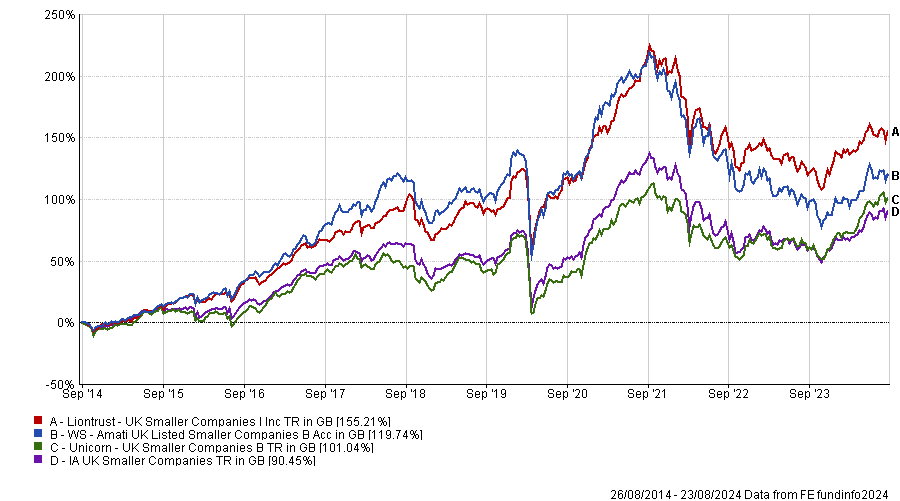Smaller companies funds and alternative investment trusts should be on investors’ radars as central banks around the world begin to cut interest rates, according to experts.
Anticipation of global interest rate cuts has already fuelled a recovery in risk assets this year, according to Darius McDermott, managing director of Chelsea Financial Services, but there will be plenty more room to run if central banks continue to slash rates.
He noted that the Bank of England's cut at its latest meeting was “significant” and should “embolden investors” to take on more risk. In addition, the Federal Reserve is widely expected to follow suit in September, meaning the “stage is set for a surge in ‘animal spirits’ in markets”.
In this environment, small and micro-caps have historically “thrived”, he said, and the evidence suggests they should be on course to do so again. So far this year, the Deutsche Smaller Companies Excluding Investment Companies index has beaten the FTSE 100 by 2 percentage points.
points ahead last year but lagged mightily (a 22 percentage point difference) in 2022 when interest rates were aggressively hiked.
“Building on this year's positive momentum, we expect further gains for the sector. UK small-caps, in particular, present a compelling opportunity,” said McDermott.
“Despite history suggesting that smaller companies considerably outperform large-caps over the long term, especially in recovering markets, they still trade at compellingly low valuations.”
In the UK, he likes the £1bn Liontrust UK Smaller Companies fund managed by FE fundinfo Alpha Managers Anthony Cross and Julian Fosh, who head the six-person team.
Using their ‘Economic Advantage’ model, the managers look for stocks with a durable competitive advantage. They also demand a stock’s management team owns at least 3% of the shares in the company, which the fund managers believe “motivates key employees, helps to secure a company's competitive edge and leads to better corporate performance”.
The fund has been the second-best performer in the IA UK Smaller Companies sector over 10 years, returning 155.2%, although it has struggled in more recent times, slipping to the third quartile over three years and the bottom 25% of the peer group over 12 months.
Performance of funds vs sector over 10yrs

Source: FE Analytics
Another with a similar trajectory is WS Amati UK Listed Smaller Companies, which is also recommended by McDermott. The fund has delivered top-quartile performance over the decade but is bottom over one, three and five years.
A more consistent option could be the Unicorn UK Smaller Companies – his third selection – which sits in the second quartile of the sector over 10 years, but has made top-quartile returns over the short and medium term.
Over in Europe, where the European Central Bank has also begun to cut rates, he suggested Janus Henderson European Smaller Companies and Jupiter European Smaller Companies.
He also highlighted emerging markets equities, which are another “traditionally higher-risk asset” that should benefit from rate cuts. The US Federal Reserve could have a big impact here. Many emerging market companies have dollar-denominated debt, so rate cuts (which should in turn lower the value of the dollar) mean their loans become cheaper.
Although there are concerns over the market instability in China, positive demographics such as young, growing populations, and expanding middle classes offer investors “the potential for strong long-term returns”.
Here, he tipped FP Carmignac Emerging Markets, FSSA Global Emerging Markets Focus and Invesco Global Emerging Markets.
Turning to investment trusts, Nick Greenwood, co-manager of the MIGO Opportunities Trust, suggested lowering rates makes it a good time to “revisit bombed-out alternative investment trusts”.
These trusts boomed over the past decade when interest rates were on the floor, giving investors a chance to earn a “decent dividend” at a time of “yield starvation”.
However, with rates rapidly rising over the past few years, their share prices have tanked. “Demand has evaporated now that it is possible to get a decent income from conventional sources such as gilts,” said Greenwood.
He believes there is an “arbitrage opportunity” as the lack of demand for these investment trusts has caused their share prices to fall to “steep discounts”, even though the market for the underlying assets they hold is, in many cases, “buoyant”.
Now, at their current prices, these trusts offer high dividend yields relative to their share prices again.
Share price performance of trusts over 3yrs

Source: FE Analytics
Yields on trusts such as Cordiant Digital Infrastructure (5.34%) and VH Sustainable Energy Opportunities (7.36%) “will attract new buyers as a decline in interest rates reduces what is on offer elsewhere”, he said.
“The general oversupply situation is steadily resolving itself via widespread buybacks, returns of capital and mergers. In the not-too-distant future, demand will no longer be swamped by supply allowing shares to trade closer to the value of their portfolios. This should mean that share prices will rise even if net asset values make no progress,” he concluded.





